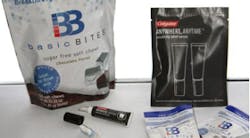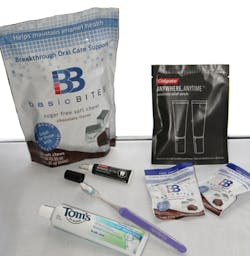Arginine: A magical weapon in the war against oral microbial diseases
For years, fluoride has been one of the most popular go-to tools in the war against oral disease. While most agree fluoride is important, the oral disease burden remains high in the US as well as in developed and underdeveloped nations throughout the world. In addition, a growing number of patients want products that do not contain fluoride. Others are looking for oral health products that they perceive have a more natural approach to preventing disease.
The nuts and bolts of arginine
Think back to high school biology. The amino acid arginine is a building block of proteins, making it an all-natural substance for the human body. The arginine molecule is bipolar, which means it has both a positive and negative charge, but its overall charge is positive. This is important since the tooth surface is negatively charged. Opposites attract.
Arginine is a natural component of healthy saliva. Numerous salivary microbes metabolize arginine via the arginine deiminase system (ADS), a three-enzyme pathway. An important metabolic by-product of the ADS is ammonia. If produced in sufficient amounts on a continuous basis, ammonia drives the oral pH to seven, a level that is favored by microbes that are found in healthy mouths.1,2 The microbes that use the ADS are known as arginolytic3 and on a microbial level, arginine is like a special dessert for these nine microbes. The more frequently that arginolytic microbes break down arginine, the greater the chance of keeping the oral pH continuously at seven.3,4 This is where the magic starts.
Used together or separately on a regular basis, products such as these can help patients achieve and maintain a neutral oral pH and homeostasis.
Impact on caries and fungal microbes
Microbes that create carious lesions and oral Candida fungal infections proliferate in an acidic environment. Acidogenic microbes are the initial heavy acid producers and thrive in low pH environments. Aciduric microbes have the capacity to tolerate a drop in pH, and over time they convert to become acid producers as well.4-6
Daily use of arginine-containing products alters the oral environment in a beneficial way. The constant production of ammonia on a cellular level causes the oral pH to rise. A neutral pH creates a hostile environment for pathogens, resulting in an oral ecology that favors health, not disease.4,7-8 When there is a continuous source of arginine, pathogens either die off or become less active metabolically, allowing the oral cavity to achieve and maintain homeostasis.2,4,6
Numerous studies using arginine-based products have demonstrated this type of ecological shift.8-11 Interestingly, this shift can take place rather quickly. Early research demonstrated that caries-active individuals can shift the microbial community from pathogens to commensal (health-promoting) microbes through daily use of toothpaste that contains 1.5% arginine bicarbonate–calcium carbonate in as little as one month.6 In addition to the changes in bacterial composition, the pH of the biofilm is no longer acidic if there is a sufficient supply of arginine.4,8Candida organisms cannot proliferate when the oral environment is maintained at a pH of seven. This reduces the risk of developing or sustaining an opportunistic oral fungal infection. The most recent studies now using 8% arginine toothpaste are reporting favorable results.12,13
Acid erosion and dentinal hypersensitivity
By definition, erosion is the loss of hard tooth structure from repeated exposures to acid. Unlike caries infection, however, erosion does not have a microbial component. Erosion is an ever-increasing threat to tooth structure and is considered a major factor in the development of dentinal hypersensitivity.14-16
There are many sources of acid, both from within the human body as well as external factors. Erosion can be a direct result of many nonmicrobial causes, including regurgitation, GERD, and frequent consumption of acidic foods and beverages. It is impossible for a tooth to demineralize at a neutral pH level; therefore, the risk of erosion decreases dramatically when the sources are eliminated or the salivary pH is maintained at seven.14-16
Fermentable carbohydrate challenges
Today’s dietary intakes are often full of sugars and starches. Many microbes use fermentable carbohydrates as an energy source. Scientists use the Stephan Curve to show a quick, dramatic, and sustained low pH level when microbes metabolize carbohydrates. Saliva that has been supplemented with arginine resists the dramatic pH shifts, therefore reducing the risk of demineralization to hard tooth structure.1,4,8
Dry mouth—fueling the fire
Improving oral pH is also of great value for those who struggle with dry-mouth issues. Patients with xerostomia or who have poor-quality saliva have limited capacity to adequately buffer oral acids. Many factors and conditions contribute to or are commonly associated with dry mouth: numerous medications, autoimmune disorders, airway obstruction leading to mouth breathing, and using a CPAP machine at night.17
It is well understood that a neutral oral pH facilitates the deposition of calcium and phosphorus into open dentinal tubules. Arginine helps create an effective biocompatible mechanical plug that prevents sensations from reaching the nerve; thus it is considered an effective desensitizer.18,19 While a single application often results in an immediate and profound reduction of sensitivity, the benefit can last up to 28 days. Repeated and regular use of arginine products ensures continued patient comfort.18-20
Degrading the biofilm slime
Studies show that arginine has the capacity to degrade the mucopolysaccharide integrity, the slimy portion of biofilm that provides protection to microbes.21 Arginine also reduces biofilm thickness and density of this extracellular matrix.22
Translating science into practical strategies
There are three different over-the-counter products available in the US today that contain 8% arginine bicarbonate–calcium carbonate. The metabolic by-products of arginolytic microbes are alkaline, resulting in a sustained buffering effect. In addition to the benefits of arginine, bicarbonate also helps neutralize the pH of the oral cavity.
Colgate's Professional Sensitivity Relief serum contains ProArgin, an 8% arginine bicarbonate–calcium carbonate formula. The serum is topically applied and can be used in the clinical setting to treat dentinal hypersensitivity, or it can be self-applied by a patient at his or her own convenience. Tubes of Professional Sensitivity Relief serum are available online in bulk quantities for use in dental offices. The small tubes fit neatly into one’s pocket or purse.
Treatment with Professional Sensitivity Relief serum provides immediate and profound relief for dentinal hypersensitivity. Apply a small drop directly onto sensitive tooth structure prior to instrumentation. Many practices use the product as a preprocedural desensitizer, and then give the tube to the patient to continue treatment after the professional application. Some practices charge a fee for desensitizing therapy; others consider the treatment as a segment of the dental hygiene appointment. The procedural code for the application of a desensitizing medicament is 9910 and should include a short narrative to describe the specific clinical use.
Tom’s of Maine Rapid Relief Sensitive toothpaste (RRS) is formulated with 8% arginine bicarbonate-calcium carbonate and is readily available in the retail market. It is the only arginine-based toothpaste sold in the US. Typically, patients who have actual dentinal hypersensitivity will experience sustained relief with daily use of the Tom’s of Maine RRS product. Optimal benefits can be derived from the paste if expectorated and not rinsed out.
Tom’s RRS paste can also be used off-label as a preprocedural desensitizer prior to scaling. It can be polished on the tooth surface with a slowly rotating prophy cup or rubbed in with a cotton-tipped applicator. Patients with dry-mouth issues may find the mint flavor profile too strong.
Current research indicates that fluoride added to an arginine toothpaste produces optimal results.9-11,23 However, at this time, a combination product is not available in the US retail market, but Colgate fluoride toothpaste with ProArgin can be obtained online or in pharmacies outside of the US. Anecdotally, some are mixing equal parts of fluoride toothpaste with the 8% Tom’s of Maine RRS toothpaste.
Imagine being able to chew a piece of candy that is actually good for your teeth. BasicBites, a novel product, is a food that has the taste and texture of a Tootsie Roll. BasicBites soft chews contain AlkaGen Technology, an arginine bicarbonate–calcium carbonate formulation, and are sweetened with sugar alcohols. These sticky candies, chewed twice daily, coat tooth surfaces with arginine bicarbonate–calcium carbonate. Each chew supplies 20% of the daily RDA of calcium. This product is available online.
Conclusion
Given the number of people who suffer from caries, dentinal hypersensitivity, dry-mouth issues, or have highly acidic diets, frequent ingestion of erosive beverages, and medical conditions/lifestyles that involve regurgitation, the opportunity to neutralize the oral pH for sustained periods of time sets the foundation for health and homeostasis. This important chemistry is now available in over-the-counter products that reduce the risk for caries, erosion, and fungal infections; neutralize oral pH values; work as effective desensitizers; and support remineralization. Over 40 years of research has demonstrated the wide range of benefits derived from using an arginine bicarbonate–calcium carbonate-based complex in the oral cavity.
References
1. Huang X, Schulte RM, Burne RA, Nascimento MM. Characterization of the arginolytic microflora provides insights into pH homeostasis in human oral biofilms. Caries Res. 2015;49(2):165-176. doi:10.1159/000365296.
2. Nascimento MM, Liu Y, Kalra R, et al. Oral arginine metabolism may decrease the risk for dental caries in children. J Dent Res. 2013;92(7):604-608. doi:10.1177/0022034513487907.
3. Chakraborty B, Burne RA. Effects of arginine on growth, virulence gene expression, and stress tolerance by Streptococcus mutans. Appl Environ Microbiol. 2017. doi:10.1128/AEM.00496-17.
4. Agnello M, Cen L, Tran NC, Shi W, McLean JS, He X. Arginine improves pH homeostasis via metabolism and microbiome modulation. J Dent Res. 2017;96(8):924-930. doi:10.1177/0022034517707512.
5. Gordan VV, Garvan CW, Ottenga ME, et al. Could alkali production be considered an approach for caries control? Caries Res. 2010;44(6):547-554. doi:10.1159/000321139.
6. Nascimento MM, Browngardt C, Xiaohui X, Klepac-Ceraj V, Paster BJ, Burne RA. The effect of arginine on oral biofilm communities. Mol Oral Microbiol. 2014;29(1):45-54. doi:10.1111/omi.12044.
7. Reyes E, Martin J, Moncada G, et al. Caries-free subjects have high levels of urease and arginine deiminase activity. J Appl Oral Sci. 2014;22(3):235-240.
8. Ledder RG, Mistry H, Sreenivasan PK, Humphreys G, McBain AJ. Arginine exposure decreases acidogenesis in long-term oral biofilm microcosms. mSphere. 2017;2(4). doi:10.1128/mSphere.00295-17.
9. Kraivaphan P, Amornchat C, Triratana T, et al. Two-year caries clinical study of the efficacy of novel dentifrices containing 1.5% arginine, an insoluble calcium compound and 1,450 ppm fluoride. Caries Res. 2013;47(6):582-590. doi:10.1159/000353183.
10. Cummins D. The development and validation of a new technology, based upon 1.5% arginine, an insoluble calcium compound and fluoride, for everyday use in the prevention and treatment of dental caries. J Dent. 2013;41(suppl 2):S1-S11. doi:10.1016/j.jdent.2010.04.002.
11. Zheng X, He J, Wang L, et al. Ecological effect of arginine on oral microbiota. Sci Rep. 2017;7(1):7206. doi:10.1038/s41598-017-07042-w.
12. Xue Y, Lu Q, Tian Y, Zhou X, Cheng L, Ren B. Effect of toothpaste containing arginine on dental plaque—a randomized controlled in situ study. J Dent. 2017;67:88-93. doi:10.1016/j.jdent.2017.10.001.
13. Koopman JE, Hoogenkamp MA, Buijs MJ, et al. Changes in the oral ecosystem induced by the use of 8% arginine toothpaste. Arch Oral Biol. 2017;73:79-87. doi:10.1016/j.archoralbio.2016.09.008.
14. Lussi A, Schlueter N, Rakhmatullina E, Ganss C. Dental erosion—an overview with emphasis on chemical and histopathological aspects. Caries Res. 2011;45(suppl 1):2-12. doi:10.1159/000325915.
15. Zero DT, Lussi A. Erosion—chemical and biological factors of importance to the dental practitioner. Int Dent J. 2005;55(4 suppl 1):285-290.
16. Huysmans MC, Chew HP, Ellwood RP. Clinical studies of dental erosion and erosive wear. Caries Res. 2011;45(suppl 1):60-68. doi:10.1159/000325947.
17. Sreebny LM, Vissink A, eds. Dry Mouth, The Malevolent Symptom: A Clinical Guide. Ames, IA: Wiley-Blackwell; 2010.
18. Bekes K, Heinzelmann K, Lettner S, Schaller HG. Efficacy of desensitizing products containing 8% arginine and calcium carbonate for hypersensitivity relief in MIH-affected molars: an 8-week clinical study. Clin Oral Investig. 2017;21(7):2311-2317. doi:10.1007/s00784-016-2024-8.
19. França-Grohmann IL, Sangiorgio JM, Viana Casarin RC, Casati MZ, Sallum AW, Sallum EA. Dentin hypersensitivity reduction using an arginine-based approach after nonsurgical periodontal treatment. Am J Dent. 2016;29(5):271-276.
20. Hall C, Mason S, Cooke J. Exploratory randomised controlled clinical study to evaluate the comparative efficacy of two occluding toothpastes — a 5% calcium sodium phosphosilicate toothpaste and an 8% arginine/calcium carbonate toothpaste — for the longer-term relief of dentine hypersensitivity. J Dent. 2017;60:36-43. doi:10.1016/j.jdent.2017.02.009.
21. Huang X, Zhang K, Deng M, et al. Effect of arginine on the growth and biofilm formation of oral bacteria. Arch Oral Biol. 2017;82:256-262. doi:10.1016/j.archoralbio.2017.06.026.
22. Tada A, Nakayama-Imaohji H, Yamasaki H, et al. Cleansing effect of acidic L-arginine on human oral biofilm. BMC Oral Health. 2016;16:40. doi:10.1186/s12903-016-0194-z.
23. Fontana M. Enhancing fluoride: Clinical human studies of alternatives or boosters for caries management. Caries Res. 2016;50(suppl 1):22-37. doi:10.1159/000439059.
Anne Nugent Guignon, MPH, RDH, CSP, provides popular programs, including topics on biofilms, power-driven scaling, ergonomics, hypersensitivity, and remineralization. Recipient of the 2004 Mentor of the Year Award and the 2009 American Dental Hygienists Association Irene Newman Award, Anne has practiced clinical dental hygiene in Houston since 1971. She can be contacted at [email protected].
About the Author
Anne Nugent Guignon, MPH, RDH, CSP
ANNE NUGENT GUIGNON, MPH, RDH, CSP, has received numerous accolades over four decades for mentoring, research, and guiding her profession. As an international speaker and prolific author, Guignon focuses is on the oral microbiome, erosion, hypersensitivity, salivary dysfunction, ergonomics, and employee law issues. She may be contacted at [email protected].


